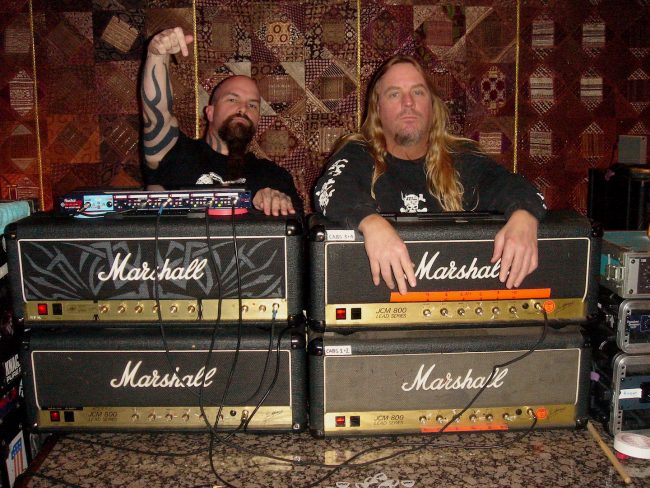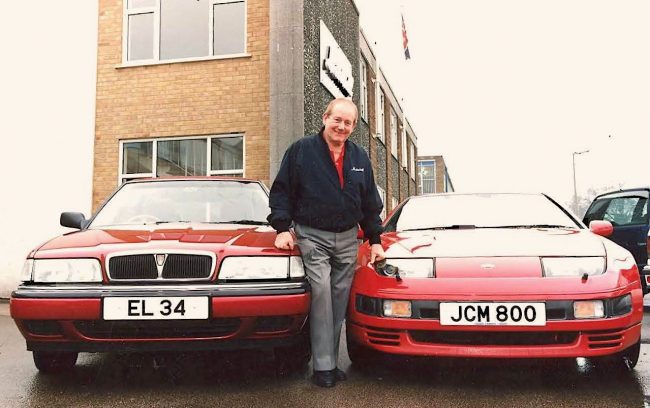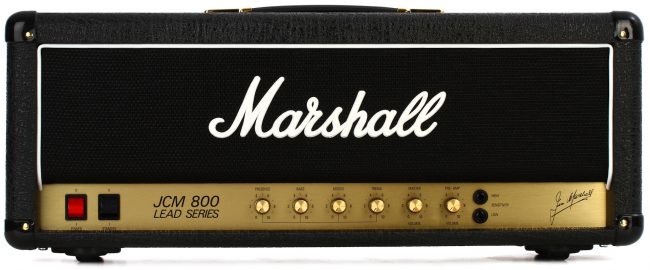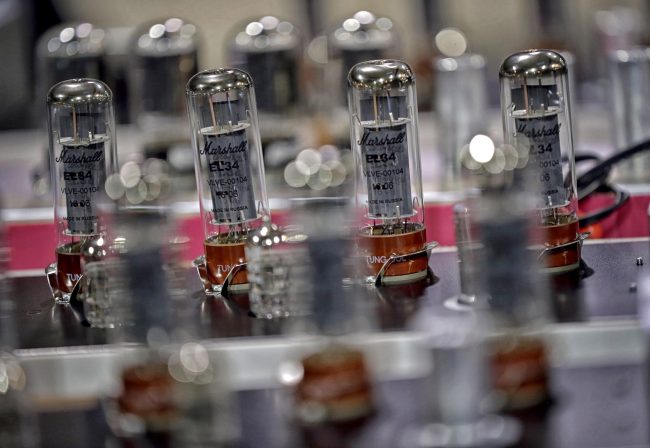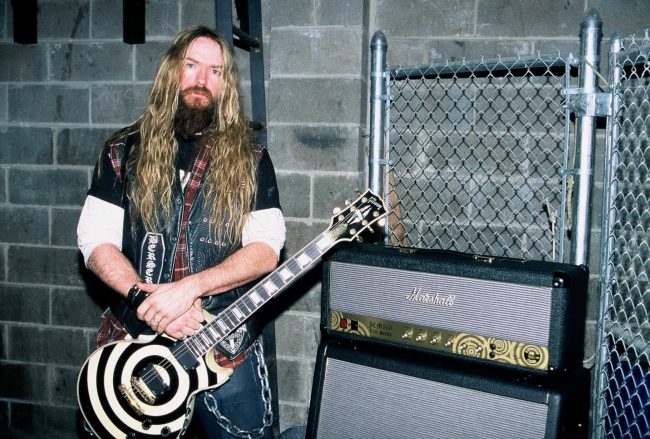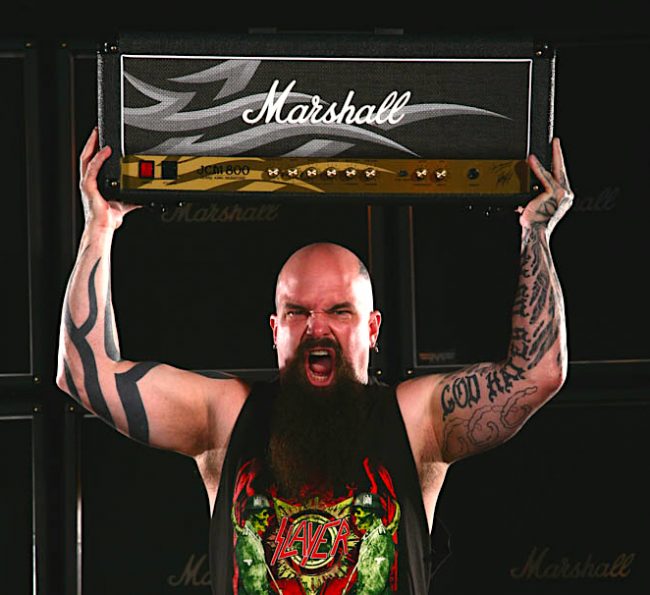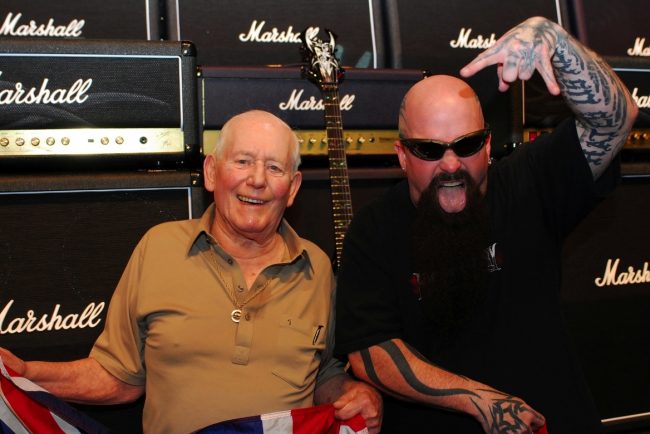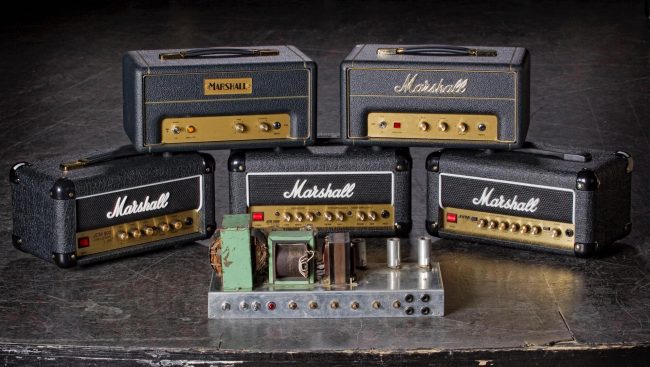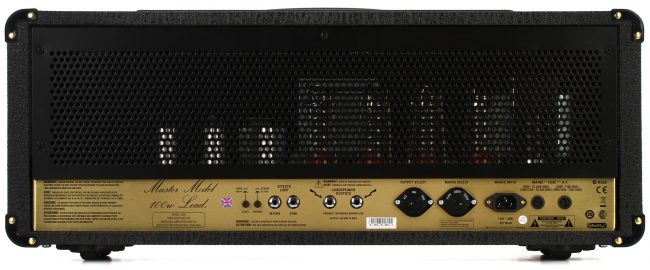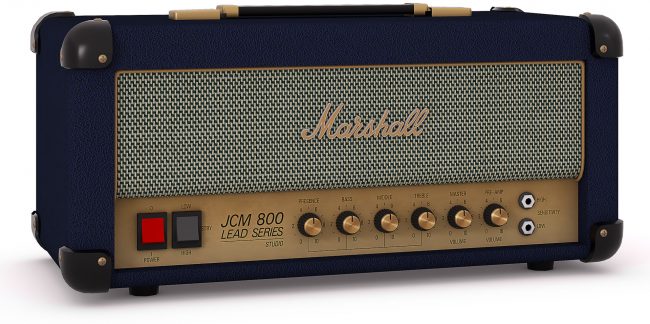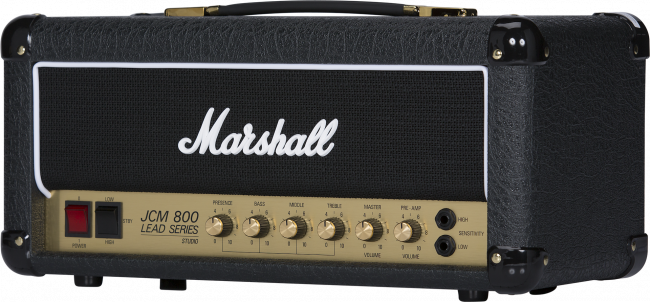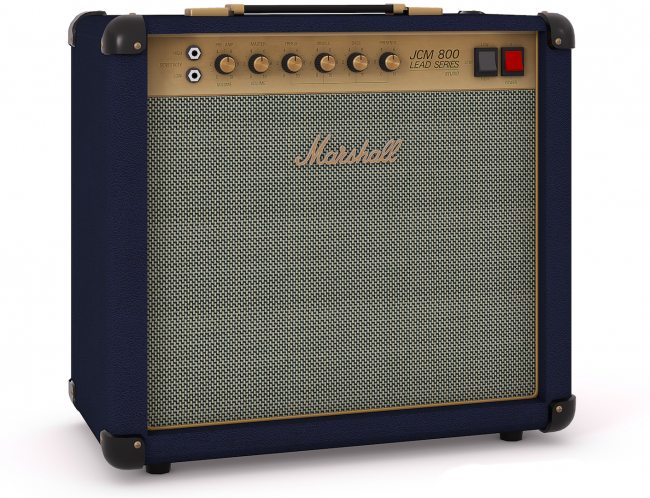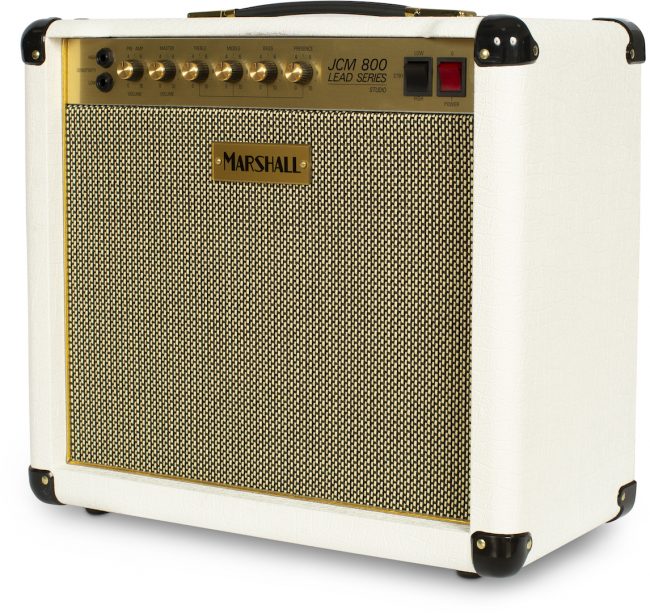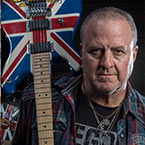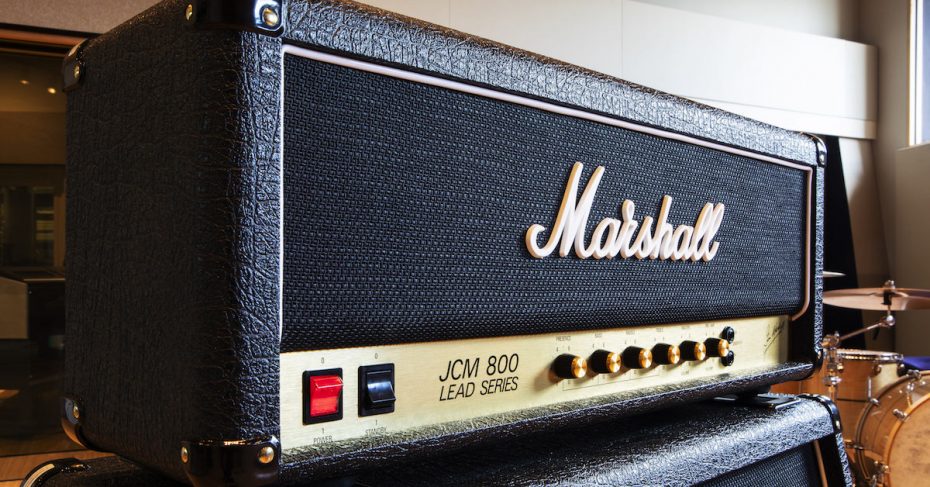
Playing through the 2203 is like flicking a switch for instant metal-hero status: imperious rock tones roll out effortlessly from your fingertips.
The Guitar Magazine, England
The 1980s were a gloriously decadent decade in the world of hard rock/heavy metal, and one amp ruled the roost on both sides of the pond — the Marshall JCM800 2203. From the rapid rise of the highly influential NWOBHM (new wave of British heavy metal) to the hair metal explosion sparked on LA’s Sunset Strip, this 100-watt, all-tube head was invariably the amp of choice, thanks to its beautifully brutal sonic punch that hits the listener squarely in the sternum.
Yes sir, when this amp and heavy metal collided, it was the perfect storm. The 2203 delivered the dynamically aggressive guitar tone that ’80s rock cried for — a thick, crunchy sound that cut through the mix while sitting perfectly within it. The fact that a wall of Marshall stacks looks ominously impressive onstage didn’t hurt either — just ask Slayer, Motorhead, Zakk Wylde, or Judas Priest, to mention a mere four!
What does a JCM800 sound like? Well, imagine attacking a Steinway concert grand piano with a very big chainsaw, and you’ll come quite close — it’s the sonic equivalent of a Rottweiler with titanium teeth.
Guitarist magazine (UK), 2002
It wasn’t just hard rockers plugging into the 2203, either. Jeff Beck; Andy Summers of the Police; Joey Santiago of the Pixies; and blues legend Buddy Guy are just four of the vast, non-metal throng who’ve used this amp for the boldness of its clean sound as well as its varying degrees of crunch — from subtle to stun. This article takes a look back at this beast’s impressive history, as its unique signature sound remains highly relevant to this very day.
The Story So Far
The legend that is the 2203 was born in 1975, and it was Marshall’s first foray into the world of Master Volume amps. Prior to the 2203, the Marshall 100-watt, Super Lead “Plexi” head was the first-call head for many classic hard-rock guitarists — and still is for more than a few. As gloriously gritty as the sound of a cranked “Plexi” is, though, without the help of a fuzz, distortion, or overdrive pedal, it just doesn’t produce the amount of distortion a lot of players desire. Also, due to the fact that it doesn’t have a Gain control, the only way to produce that famous “Plexi” tone is to literally turn it up to a Spinal Tap-approved “11” so those EL34 power tubes can work their magic. And that, my friend, just ain’t practical (or eardrum friendly) in most situations.
If you’ve ever stood in front of a cranked-to-the-max Marshall Super Lead and hit an open A5 power chord, you know firsthand exactly why the late, great Jim Marshall was often referred to as “the father of loud.” It’s literally deafeningly loud… in a glorious, trouser-flapping way! That’s fine and dandy if you’re headlining Madison Square Garden in New York or Wembley Arena in London, but if you’re a mere metal mortal playing bars and clubs, this is just not practical. Sure, nowadays, you can utilize a power attenuator to “tame the beast,” but in the mid-’70s such devices didn’t exist.
At this stage of the story, I guess a quick explanation of what exactly a Master Volume amp is and a simple, “guitarist-friendly” explanation of how one “does what it does” is called for.
Master Volume Amps Explained
Simply put, this now-common amp design doesn’t just have an overall Volume control; the 2203 also boasts a “Preamp Volume” (a.k.a. Gain on certain amps) control. The Gain knob allows the user to dial in the desired amount of distortion in the amp’s preamp section while keeping the amp’s overall volume low. The overall output level is determined by the Master Volume control — hence the logical “Master Volume” name. Below are labeled photos of the front panels of both a Marshall Super Lead and also a JCM800 2203, so you can see the difference.
How Does the Preamp Volume (a.k.a. Gain) Control Work?
In a tube amp, there are essentially two families of tubes — preamp tubes and power amp tubes. Simply put, if you look in the back of a tube head, you’ll typically see a row of two (50-watt amp) or four (100-watt amp) big glass tubes, and also a group of smaller ones — as in the photo below. The big boys reside and work in the power amp; the small ones are the preamp tubes.
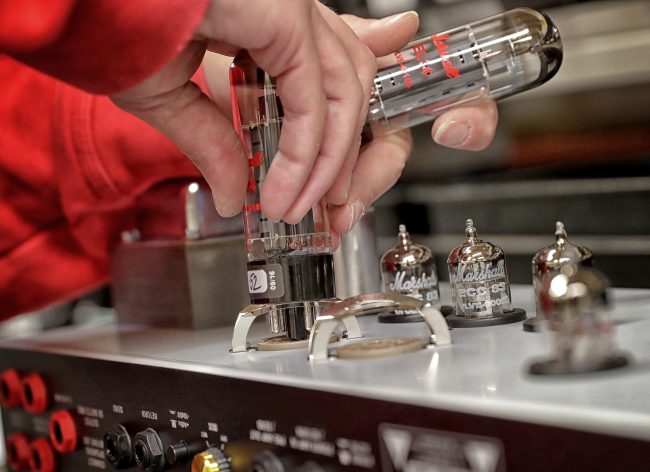
For more information on the difference between the functions of the preamp and power amp, please check out these articles: “What Does a Preamp Do?” and “What Does a Power Amp Do?”
In a high-gain amp, the preamp tubes are typically 12AX7s (a.k.a. ECC83s in England). Why? Because they are capable of producing the most gain. As it just so happens, a 12AX7 is what is known as a dual-triode* tube — a fancy term effectively meaning “two tubes in one.”
This means that a single 12AX7 tube actually contains two gain stages — make sense?
NOTE! The word “triode” is a shortened derivation of “tri-electrode,” which simply means “three active elements,” as “tri” is the Greek word for “three.” What these three elements are and what they do will be explained in an upcoming article. Stay tuned…
So, to create more gain capability in the preamp section, these tube gain stages are put in a chain and then literally cascaded into each other — thus producing more gain and also compression/sustain in the preamp section. That’s what the preamp gain control, er, controls!
At this point, it would be pertinent to point out that Randall Smith, the founding father of Mesa/Boogie, is responsible for the innovation that is the high gain producing, cascading-gain preamp. He released this to the general public in 1972 in the form of the revolutionary Mark I Boogie combo.
While Boogie were the first kid on the high-gain block, when Marshall unleashed the 2203 in the mid-’70s, it was a game-changer due to its aggressive yet hard-rock-friendly roar.
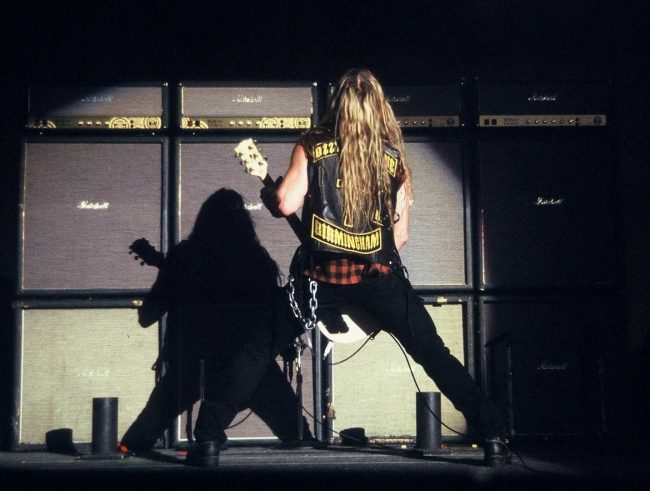
1975: The Marshall 2203 Is Born
Due to the increasing demand for more distortion and sustain at lower volume levels, Marshall stepped up to the plate with their Master Volume series in 1975. “That amp came about because the guitarists at the time wanted the Marshall sound, but in some venues, they had to turn down. They couldn’t run at full power,” Jim told me when I worked on Rich Maloof’s excellent book, Jim Marshall – The Father of Loud, in the early 2000s.
Essentially, Marshall’s designers took the tried, tested, and player-approved 100-watt (Model 1959) and 50-watt (Model 1987) Super Lead head platforms, cascaded the preamp gain stages, and added a preamp Gain control to allow the desired overdrive to be dialed in. The two resulting heads were the 50-watt 2204 and the 100-watt 2203. Both sold like those proverbial hotcakes, and the 2203 soon became the stuff of legend.
It became the standard by which all other rock amps were judged for the whole of its 15-year production life. It was simplicity itself to use: all-valve design, one channel, no effects loop, and crunchier than a lorry running over a hedgehog!
Michael Doyle on the 2203 from The History of Marshall: The First Fifty Years
The initial look of the Master Volume heads was very “Super Lead-like.” The only visual difference to the casual glance? Two vertical inputs (high and low sensitivity) as opposed to the Super Lead’s four.
Amp Trivia: The JMP on the front panel is an acronym for “Jim Marshall Product”
1981: the JCM800 Series Is Introduced & the 2203 Gets a Facelift!
Way back in 1966, not only did the England soccer team win the World Cup, but Jim Marshall signed an international distribution deal with a company called the Rose-Morris Agency. Unfortunately, said company’s exorbitant 55% price markup on exports meant that Marshall amps purchased outside of England’s green-and-pleasant land were hardly cheap. So, when that contract finally expired in early 1981, the JCM800 line was born.
As the JCM800 line existed for the entire decade it dominated, many logically assumed that the “800” was a nod to the ’80s — especially when the 900 series followed in the ’90s! In truth though, it was pure happenstance! The “JCM” stands for Jim’s full initials — James Charles Marshall. As for the “800” part? Here’s the actual story in “Guv’nor” Jim’s words.
“I wanted a new name for the amps, but every idea we came up with was dreadful,” he recalled with a chuckle. “And then, one day, I looked at the number (license) plate on my car and immediately thought, ‘That’s it — that’s what we’ll use.’ It was staring me right in the face all along!”
Facelift Time!
When the JCM800 line hit the streets in May 1981, the only difference between the JMP 2203 and the new JCM800 version was purely aesthetic. As you can see in the picture below, these changes were as follows:
- Much larger Marshall logo
- White piping frame around the baffle
- Baffle covered with cabinet grille cloth instead of vinyl
- Baffle no longer pillarbox because…
- Control panel now stretched across the full width of the head
- Jim Marshall’s signature added to the right-hand side of the front panel
- “JCM 800 LEAD SERIES” added in bold lettering on the panel’s left-hand side
This said, the plot did thicken in the USA. Read on.
2203 Power Tubes: EL34 or 6550?
From its very inception, the 2203 had a quartet of EL34 power tubes — an integral part of their “British” tonal character. When the JCM800 series came to be, however, Marshall’s American distributor at the time insisted that all US JCM800s come with 6550 tubes instead of EL34s, as they deemed them more reliable.
As you’d expect, this change had a tonal impact, as 6550s and EL34s each have their own unique sonic characteristics. EL34s break up quicker and have a crunchy yet warm midrange “thump.” In comparison, 6550s have more lows and a harder, more aggressive edge to them. They’re also harder to overdrive and so have more headroom. In short — both sound good, but they sound and feel very different from one another. Not surprisingly though, some were confused as to why JCM800 2203s sounded so different in England versus in America. And vice versa!
In the mid-’80s though, Marshall’s American distributor changed, and, to Jim’s delight, US JCM800 models were loaded with EL34s.
1986: None More Metal. Additional Aggression if 2203 Really Cranked
In 1986, a change was made to the reservoir caps (capacitors) in the HT (High Tension Voltage) supply of the 2203 in order to make production more cost-effective and efficient. In 2011, when I was working on The History of Marshall: The First Fifty Years with Marshall history expert Mike Doyle, I decided to dig into the resulting electrical and sonic impact this change instigated. So, I asked Steve Dawson, an R&D maven responsible for several fine Marshall amps (including the criminally overlooked Vintage Modern series), to explain this in simple, “guitarist-friendly” terms. Here’s a summary of what Steve told me: “This component change increased the total capacitance, making the HT supply more efficient in ‘keeping up with the power demand’ when the amp is really cranked. The result was a decrease in both power amp ‘sag’ and compression when the 2203 is pushed hard, making it even more aggressive.”
Some preferred this “new way,” others preferred the “old way,” and many didn’t notice a change at all. Why didn’t they notice? Simply because, as already mentioned, you had to have the amp cranked up to hear and feel the difference — and, for many venues, sound engineers, and ears, that was simply too darned loud!
If you have an original ’80s JCM800 2203, if it has its two front-panel inputs aligned vertically, you’ll instantly know that it doesn’t have this change. This is because the inputs weren’t changed to being horizontal until 1985.
If, however, your 2203 does have horizontal inputs, then you’ll have to take a look at the serial number in order to find out its year of manufacture. Said year is designated by the very last letter before the numbers start. Here’s the skinny:
- T = 1985 (“old way”)
- U = 1986 (maybe “old,” maybe “new” — sorry)
- V = 1987 (“new way”)
- W = 1988 (“new way”)
- X = 1989 (“new way”)
- Y = 1990 (“new way”)
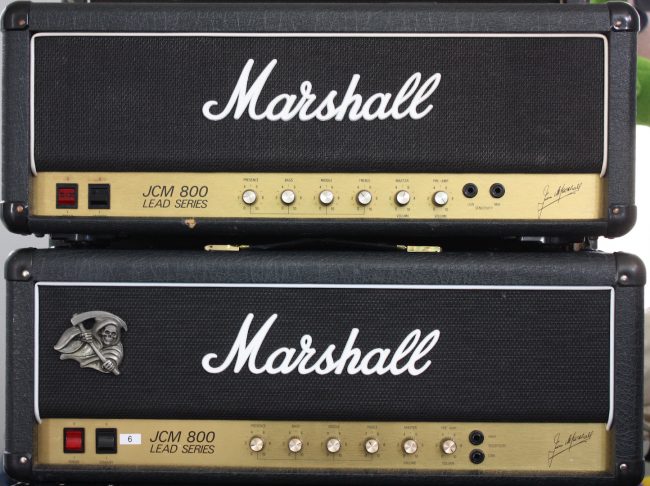
1990: New Decade, New Marshall Series & the 2203 Is Retired
Even though the 2203 dominated the rock arena for a good 15 years, by the end of the ’80s, the demand for more and even more gain was undeniable. As a result, there was a slew of experts modifying amps to produce more gain. Some of said mods were amazing, others weren’t, but they all had three things in common — they voided the manufacturer’s warranty; they invariably devalued vintage amps; and they were expensive. Oh, and in some cases, there were two other major issues: significant added noise and serious reliability issues.
As a result, Marshall wisely decided to satisfy the increasing lust for more by offering a new high-gain series in January 1990. Enter the JCM900 series (which had a Gain control that went to 20!) and exit the JCM800 series. Yep, after a game-changing, amazing run, the by-then legendary 2203 was put out to pasture…
Even though the 2203 was no longer being made, it remained in the arsenal of many artists and continued to be a mainstay in many recording studios. It also remained a hot seller on the secondhand market. One of the countless artists who remained true to their tried and trusted 2203 arsenal was hard-rock guitar hero Zakk Wylde of Ozzy Osbourne and Black Label Society fame. Another? Kerry King of Slayer. The reason I mention these two in particular? Read on…
JCM800 2203ZW Zakk Wylde Signature Model
He may look like a weird and wonderful cross between a Viking, a wrestler, and a biker, but Zakk Wylde is a bona fide guitar hero on a global scale. In 2002, Mr. Wylde became the second artist to have his signature on the front panel of a Marshall alongside Jim’s — the first one being Slash in 1996.
Marshall decided to celebrate Zakk’s synonymous relationship with the JCM800 2203 by working with the guitarist on a limited-edition signature model of his favorite amp. The result was the 2203ZW — a faithful reissue of an early JCM800 model, complete with 6550 power tubes since that was the American way back then. The aesthetics, as you can see in the picture below, were 100% Wylde. Cosmetics aside, just like the 2203X reissue (which I’ll tell you about soon), the Zakk model featured a true-bypass, series FX loop on the rear panel. Only 600 were made, and they sold out instantly.
JCM800 2203KK Kerry King Signature Model
Love them or loathe them, Slayer’s impact and influence on modern metal is irrefutable. They not only created a brutal genre, but they still remain the standard by which all others who dare enter it are judged, even though they called it a day after a glorious 39-year run in late 2019.
At the epicenter of Slayer’s sonic storm was the JCM800 2203-fueled fury of guitarists Kerry King and Jeff Hanneman (RIP). Kerry King is an avid collector of 2203s, and one of them he considers to be his “holy grail.” “I’ve got a bunch of killer-sounding 2203s,” he told me in the early 2000s, “but that one is superhuman. I call it ‘the Beast.'”
King trusted Marshall with “the Beast,” and the company measured each and every component so it could be cloned exactly. Many assumed it was modified, but it was 100% stock. Due to component tolerances (or lack thereof!) in the mid-’80s, though, and also to “drift” caused by age, the amp was perfect for Kerry’s axe assault.
The resulting 2203KK also featured KT88 power tubes at King’s request, Celtic lettering on the front panel, and tribal flames on the baffle — a nod to the guitarist’s trademark tattoos. It also featured a single input (like 99.999% of metal players, King never uses the 2203’s Low Sensitivity input option — duh!), a studio-quality noise gate, and also Slayer’s “secret weapon” on a control aptly labeled “Assault.” What did Assault do? It replicated the unique “mid-bump” EQ curve that Slayer hit their ears with via a Boss 10-band graphic EQ. What was said curve? That will be covered in an upcoming article entitled “Mids & Metal: Is Less Really More?” Stay tuned.
The 2203KK is no longer in production but proved to be very popular — and not just with metalheads. Believe it or not, it was used by a Top 10 country band!
Kerry with his signature head and with Jim at its launch.
Mini Me(tal): the Limited Edition JCM-1H Head & JCM-1C Combo
To celebrate their 50th anniversary in 2012, Marshall released five pairs of limited-edition 1-watt, all-tube heads and combos — each one celebrating and paying homage to a decade. Not surprisingly, the ’80s choice was the JCM800s. And the line’s unchallenged king — the 2203 — was a key tonal target.
Now, we’ve dealt with these two notable JCM800 2203 signature heads and the mini tribute twins, so let’s look at the Marshall 2203X reissue, which is currently available.
2002: JCM800 2203X Reissue – Don’t Call It a Comeback!
Even though the JCM900 series that replaced the JCM800 line was a best seller for Marshall, a growing public demand made it clear that a reissue of the 2203 was called for. So, in 2002, Marshall answered this call with the UK-built JCM800 2203X reissue.
To do this, Marshall’s guitar-playing R&D team at the time (who later left the company to form the successful Blackstar amp company) found the best-sounding early ’80s (vertical input) 2203 in the company’s impressive collection of vintage amps and duplicated it… what a concept! It took them a good year, due to strict modern-day safety regulations regarding all things electrical (simply put — it would be illegal to build an old 2203 “as was” today. Sad but true, my friend, sad but true), but their hard work paid off as the excerpt below from an English review of the 2203X proves.
It took Marshall a painstaking year to recreate these classic amps. Going down to the auditorium built behind the factory and plugging them in, it’s easy to see that the time was well spent. Playing through the 2203(X) is like flicking a switch for instant metal-hero status: imperious rock tones roll out effortlessly from your fingertips.
The Guitar Magazine, UK
The resulting Marshall monster is still available to this day, and not surprisingly, as it’s not only a cornerstone of rock, but — alongside the JTM45 head, Bluesbreaker combo, and the “Plexis” (Model 1987 = 50W; Model 1959 = 100W) — it also literally helped shape the six-string rock sounds we so often take for granted!
Oh — to also satisfy “public demand,” a series FX loop was added to the rear panel of the amp. Not surprisingly, such a move would greatly upset vintage-amp purists, but an indignant outcry was circumvented by the inclusion of a true-bypass switch on this potentially offensive addition!
Flavor Fav: The Current 20-watt Marshall Studio Classic Offerings
Over the last couple of decades, lower-wattage tube amps have become an increasingly viable and popular item for guitarists of all walks. Not surprisingly, in 2019, Marshall launched the 20-watt Studio Classic head and combo as a “portable replica of the classic JCM800 2203” for “musicians that want to create nostalgic music memories in your own home or studio.”
Made in the UK, both in this pair house 3 x 12AX7 (a.k.a. ECC83) and 2 x EL34 tubes, feature a series FX loop, and offer a 5-watt power switch for even lower wattage. While a pair of EL34 power tubes in a Marshall typically means 50 watts (4 x EL34 = 100-watt… duh!), Marshall have cleverly redesigned the Studio Classic power amp to deliver the sound and feel of a 2203 but at a much lower output.
While no 20-watt amp on the planet (tube or not) will ever be able to duplicate the unadulterated, paint-peeling, trouser-flapping, face-melting power of a cranked JCM 2203 100-watt stack or three, the Studio Classic amps have deservedly garnered rave reviews and impressive sales. The fact that artists of the caliber of Doug Aldrich (The Dead Daisies, Dio, Whitesnake), Gary Holt (Exodus, Slayer), Lzzy Hale (Halestorm), Lee Malia (Bring Me The Horizon), and John 5 have all waxed lyrical about the SC20H head is also a rock-solid endorsement! In Brit-speak, the Studio Classic is “a result!”
I’ve owned a few JCM800 heads, and the SC20H took me back to what it felt like to hear a Marshall 2203… For their size and mammoth tone, these Marshalls are pure magic.
Guitar World, Studio Series review
The Studio Classic head has two finish options to choice from… a 1×10″ combo too…
Granted, the original JCM800s were never offered with a classic “block” Marshall logo, but it looks really neat anyway & we’ve got them!!
Conclusion
Even though the 2203 is the epitome of KISS — keep it simple, stupid — this no-nonsense, one-channel, 100-watt, all-tube, fire-breathing British bastion has deservedly earned its highly heralded status. And, even though it is now over 45 years old, its unmistakable tone is still rightfully considered a gold standard in hard rock and heavy metal. While the terms “legendary” and “timeless” have sadly lost a lot of their clout due to flippant misuse, both truly apply to the JCM 2203.


